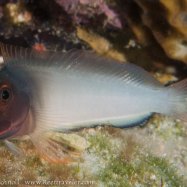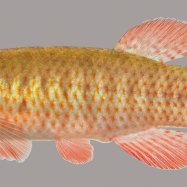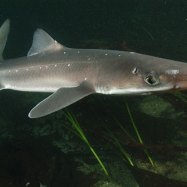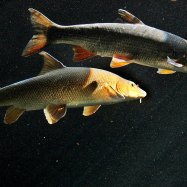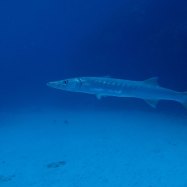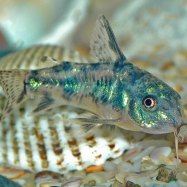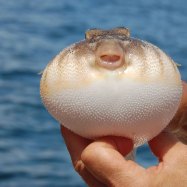
Inconnu
Anadromous - migrates from saltwater to freshwater for spawning
The Inconnu fish, also known as the Sheefish, is a large anadromous fish found in Canada, the United States, and Russia. They can live up to 20 years and migrate from saltwater to freshwater for spawning. Watch out for these magnificent fish during their annual spawning season! #InconnuFish #AnadromousMigration #SpawningSeason #FreshwaterFish
Summary of Fish Details:
Common Name: Inconnu
Habitat: Freshwater rivers and lakes
Color: Silver to bronze
The Mighty Inconnu: A Mysterious Fish of North America and Siberia
When we think of freshwater fish, our minds often go to well-known species like trout, salmon, and bass. But have you heard of the Inconnu? This elusive and fascinating fish is found in the rivers and lakes of North America and Siberia, and yet many people have never even heard its name.The Inconnu, or Stenodus leucichthys, goes by several other names such as coney-fish, connie, and sheefish. However, its scientific name is derived from the Greek words "stenos" meaning slim, and "odus" meaning tooth, which accurately describes its elongated body and sharp teeth Inconnu.
Native to Canada and the United States, as well as parts of Russia, the Inconnu is a species that has remained shrouded in mystery for many years. As its name suggests, the Inconnu is still relatively unknown to many people - but don't underestimate its power and importance in the ecosystem.
So, let's dive deeper and discover the amazing facts about this remarkable fish.
A Habitat Unlike Any Other
The Inconnu is a freshwater fish, but its habitat is not limited to rivers and lakes. It is also found in the estuaries and brackish waters of the Arctic Ocean, Hudson Bay, and Bering Sea. These areas provide the perfect combination of freshwater and saltwater for the Inconnu to thrive.But don't expect to find the Inconnu just anywhere in these bodies of water. It is known to prefer colder temperatures and can often be found in deeper, colder sections of a river or lake. This makes them difficult to spot and catch, adding to their enigmatic nature Inanga.
A Versatile Diet
One of the most intriguing things about the Inconnu is its feeding habits. As a predatory fish, it has a diverse and adaptable diet. It can feed both benthically - meaning at the bottom of the water - and pelagically - meaning in the open water.This versatility in feeding allows the Inconnu to thrive in various environments and adapt to changes in its habitat. It can feed on a variety of aquatic plants, small fish, and even insects that fall on the surface of the water. This makes it an essential part of the food chain in the areas where it resides.
An Impressive Size and Longevity
The Inconnu may not be a household name, but it certainly should not be underestimated. It can grow up to 1 meter (3.3 feet) in length and weigh up to 27 kilograms (60 pounds). Its large size and muscular body make it a formidable fish, and it is a popular target for sport fishing.But what is even more remarkable is its longevity. The Inconnu can live up to 20 years, making it one of the longest-lived freshwater fish in North America. This impressive lifespan allows it to play a vital role in maintaining a healthy and balanced ecosystem.
The Mysterious Reproduction Behavior
In addition to its feeding habits and size, the Inconnu also has a mysterious reproductive behavior. It is a sexual species, with males and females coming together for the act of spawning. However, very little is known about this process due to its elusive nature.What is known is that the Inconnu migrates from its habitat in the estuaries and brackish waters to spawning grounds in freshwater rivers. This behavior is called anadromous, where the fish migrate from saltwater to freshwater for spawning. This behavior is similar to other well-known anadromous species such as salmon.
The Value of the Inconnu
While the Inconnu may not be as well-known as other freshwater fish, it is still an important species. First and foremost, Inconnu are crucial for maintaining the balance of the ecosystem. As a predator, they keep populations of smaller fish in check, preventing overpopulation and depletion of resources.In addition, the Inconnu is a vital cultural and economic resource for indigenous communities that depend on it for subsistence and cultural traditions. It also holds value for recreational and commercial fishing, contributing to local economies and the well-being of communities.
Conservation Efforts for the Inconnu
Despite its cultural and economic value, the Inconnu faces threats and challenges that put its population at risk. Overfishing, habitat destruction, and pollution are all factors that contribute to the declining population of this species. In response, conservation efforts have been put in place to ensure the survival of this magnificent fish.For example, catch-and-release fishing is encouraged in many areas to reduce the impact of recreational fishing on the population. Restoration projects have also been initiated, such as the development of spawning channels to protect the Inconnu's spawning grounds and ensure successful reproduction.
The Mystique Continues
As elusive as the Inconnu may seem, it is a species that continues to intrigue and fascinate scientists and fishermen alike. With its mysterious behavior, impressive size, and value to the ecosystem and communities, there is much still to be discovered about this magnificent fish.From its origin in Canada, the United States, and Russia to its migration patterns and importance in the food chain, the Inconnu is a species that deserves more recognition and protection. So next time you're out fishing or exploring the great outdoors, keep an eye out for this mighty and enigmatic fish. Who knows, you may just catch a glimpse of the elusive Inconnu.
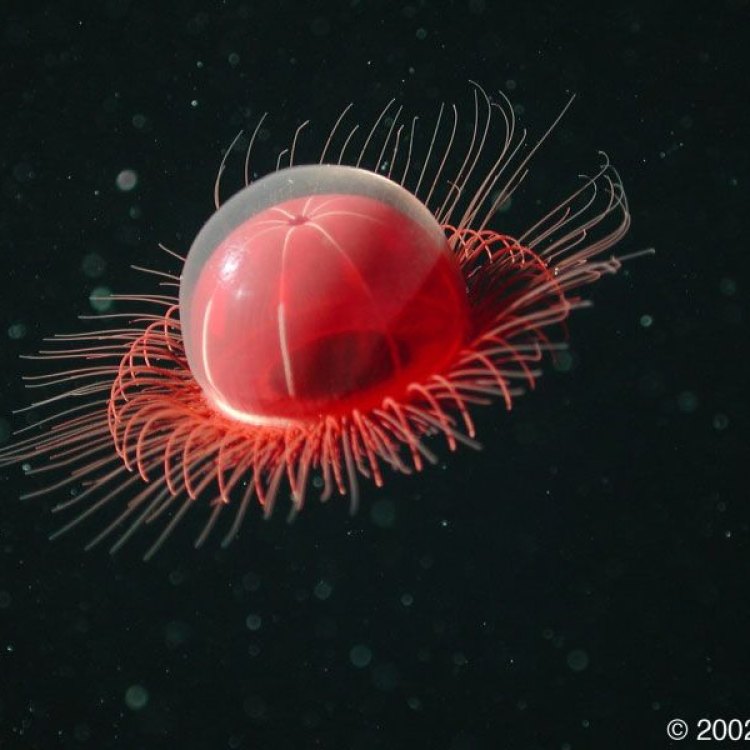
Inconnu
Fish Details Inconnu - Scientific Name: Stenodus leucichthys
- Category: Fish I
- Scientific Name: Stenodus leucichthys
- Common Name: Inconnu
- Habitat: Freshwater rivers and lakes
- Feeding Habitat: Benthic and pelagic
- Feeding Method: Predatory
- Geographic Distribution: North America and Siberia
- Country Of Origin: Canada, United States, Russia
- Color: Silver to bronze
- Body Shape: Elongated body, similar to a trout
- Length: Up to 1 meter (3.3 feet)
- Adult Size: Up to 1 meter (3.3 feet)
- Age: Up to 20 years
- Reproduction: Sexual
- Reproduction Behavior: Migrations to spawning grounds
- Migration Pattern: Anadromous - migrates from saltwater to freshwater for spawning
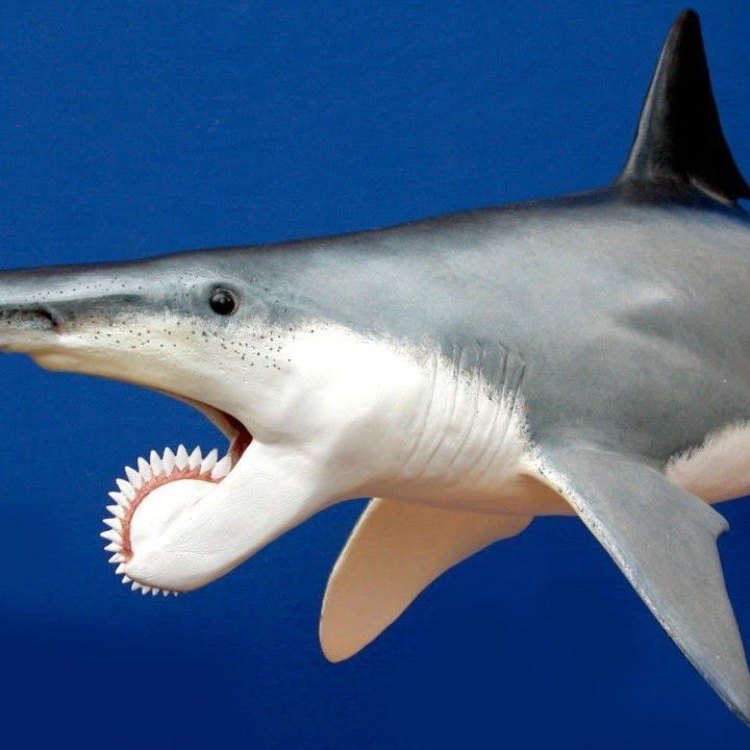
Inconnu
- Social Group: Solitary or form small groups
- Behavior: Active during daytime, migratory
- Diet: Feeds on small fish, insects, and crustaceans
- Predators: Bears, birds, larger fish
- Prey: Small fish, insects, crustaceans
- Environmental Threats: Habitat degradation, overfishing
- Conservation Status: Least Concern
- Special Features: Large size, migratory behavior
- Interesting Facts: Inconnu is the largest freshwater whitefish species, known for its strong fighting ability
- Reproduction Period: Spring
- Nesting Habit: Gravel or rocky substrate in freshwater rivers
- Lifespan: Up to 20 years
- Habitat Threats: Dams, pollution, habitat destruction
- Population Trends: Stable
- Habitats Affected: Freshwater rivers and lakes

Stenodus leucichthys
The Fascinating Inconnu: The Largest Freshwater Whitefish
Nestled in the cold, clear waters of the Northern Hemisphere, lives a magnificent and elusive creature known as the Inconnu. This extraordinary fish is revered for its impressive size, resistance to capture, and migratory behavior. With a diet consisting of small fish, insects, and crustaceans, the Inconnu is a vital part of its ecosystem and plays a significant role in maintaining the balance of freshwater habitats. Yet sadly, this majestic species faces numerous environmental threats that put its survival at risk RadioDouRosul.com.In this article, we will dive deep into the world of the Inconnu and discover its unique characteristics, behavior, and threats, and learn why it is a species that deserves our attention and conservation efforts.
The Basics: What is Inconnu?
Inconnu, also known as Sheefish or Conyfish, is the largest freshwater whitefish species in the world. Its name translates to "unknown" in French, given due to its mysterious nature and the little information available about its biology and behavior.This remarkable species is found in the cold waters of northern and western North America and northeastern Siberia. It inhabits freshwater rivers, lakes, and streams, particularly in Arctic and sub-Arctic regions, such as the Yukon River in Alaska, the Mackenzie River in Canada, and the Lena River in Russia.
Solitary or Form Small Groups
Inconnu are primarily solitary creatures, and they are often found alone or in small groups. However, during the spawning season, which occurs in the spring, they may gather in large numbers in their native rivers to reproduce. These gatherings, known as spawning shoals, can contain up to 1000 individuals.Active During Daytime and Migratory Behavior
Unlike most whitefish species, which are nocturnal, the Inconnu is active during the daytime Icefish. They can often be seen swimming in shallow waters near the surface, making them a sought-after species for anglers looking for a challenging catch.One of the most unique traits of the Inconnu is its migratory behavior. They are anadromous, meaning they spend most of their lives in freshwater but migrate to the saltwater of the Arctic Ocean to feed and grow during summer. This makes them a vital link between freshwater and marine ecosystems, playing a crucial role in maintaining the balance of both.
The Diet of the Inconnu
The Inconnu has a varied diet, feeding on small fish, insects, and crustaceans. Their preferred prey includes Arctic lamprey, cisco, and whitefish. They are opportunistic and will also consume whatever is available in their environment, such as shrimp, snails, and small mollusks.As predators, Inconnu play a vital role in controlling the population of their prey and maintaining the balance of their ecosystem.
Predators and Prey
Despite their large size and strong fighting ability, Inconnu face threats from natural predators such as bears, larger fish, and birds of prey. They are also vulnerable to human activities, such as overfishing and habitat degradation, which reduce their ability to evade predators and decrease their population.As for prey, Inconnu are an important source of food for apex predators, such as bears and larger fish. They also provide a vital food source for indigenous communities who rely on fishing for their subsistence.
Conservation Status: Least Concern
According to the International Union for Conservation of Nature (IUCN) Red List, the Inconnu is currently listed as a species of least concern. This is due to its widespread distribution, stable population trends, and low levels of exploitation.However, this does not mean that the Inconnu is not facing any threats. Environmental factors, such as habitat degradation, overfishing, and climate change, continue to pose significant risks to the species and their habitats. Therefore, continued monitoring and conservation efforts are crucial in ensuring their long-term survival.
Special Features: Large Size and Migratory Behavior
The Inconnu is a truly impressive species, known for its large size and migratory behavior. They can grow up to 3.5 feet in length and weigh over 30 pounds, making them the biggest freshwater whitefish species in the world.Their schooling behavior and migratory patterns also make them a unique and fascinating species. They are constantly on the move, traveling long distances between freshwater and saltwater habitats and playing a vital role in the health of both ecosystems.
Interesting Facts about Inconnu
Apart from their size and behavior, there are many interesting facts about the Inconnu that make it a fascinating species to learn about. For example, did you know that:- Inconnu is known as the "tarpon of the North" due to their strong fighting ability and acrobatic jumps when hooked.
- The Inconnu has a life expectancy of up to 20 years.
- They are also known as the "ice salmon" or "ice fish" because they can be caught through holes in the ice during the winter.
- They have large mouths with sharp teeth, giving them a fierce appearance.
- They are an important part of indigenous culture and are considered a sacred species in some communities.
Reproduction and Nesting
Inconnu have a spawning season that occurs during the spring when water temperature and flow are suitable for reproduction. Unlike some fish species that spawn in open water, Inconnu prefer to spawn in shallow, gravel-bottomed or rocky areas in rivers and streams.Females can release up to 500,000 eggs, which are then fertilized by males. The eggs hatch in less than a week, and the young fish, called fry, stay in the shallow waters near the shoreline for several weeks before migrating to deeper waters.
Habitat Threats and Population Trends
Inconnu inhabit freshwater rivers and lakes, making them vulnerable to various environmental threats such as dams, pollution, and habitat destruction. These activities disrupt their migratory patterns and prevent them from reaching their spawning grounds, which can result in a decline in their population.Fortunately, the population trend of Inconnu is currently stable, thanks to conservation efforts and strict regulations on fishing limits in some areas. However, these threats still pose a significant risk to the species, and continued monitoring and conservation efforts are necessary to maintain a healthy population.
Conclusion
In every aspect, the Inconnu is a remarkable and unique species that deserves our attention and conservation efforts. With its impressive size, migratory behavior, and crucial role in freshwater and marine ecosystems, it is a vital part of our natural world.However, this majestic fish faces numerous threats, both natural and human-made, that put its survival at risk. Therefore, it is essential to raise awareness and take actions to protect their habitats and ensure their long-term survival. By doing so, we not only preserve a valuable species but also maintain the delicate balance of our ecosystems that depend on the Inconnu.
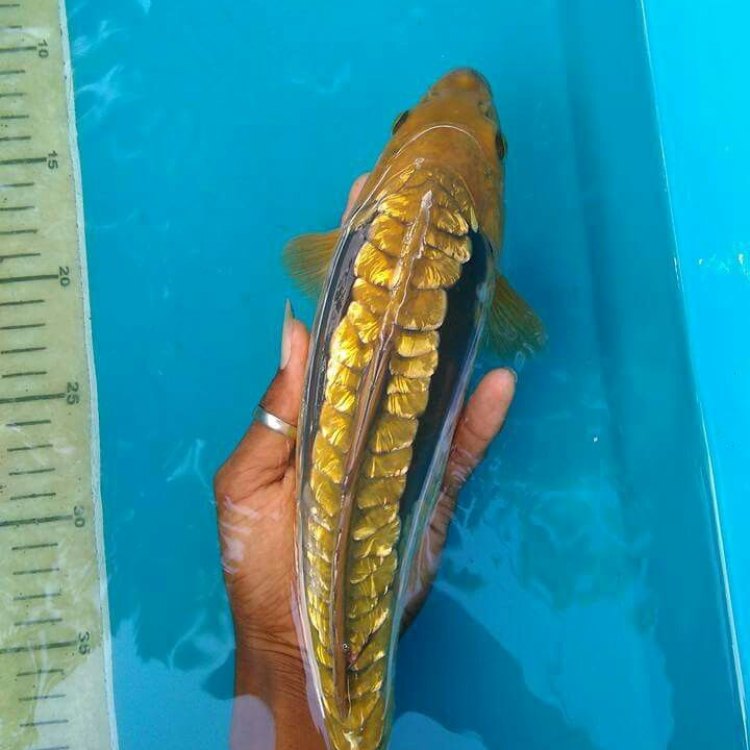
The Mighty Inconnu: A Mysterious Fish of North America and Siberia
Disclaimer: The content provided is for informational purposes only. We cannot guarantee the accuracy of the information on this page 100%. All information provided here may change without prior notice.

